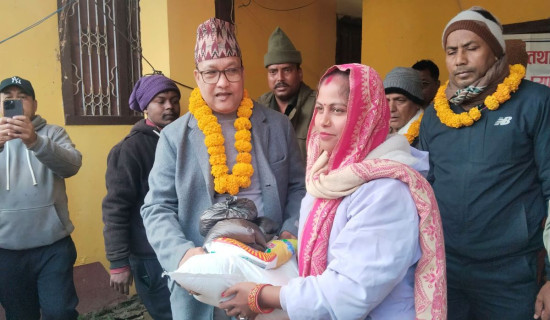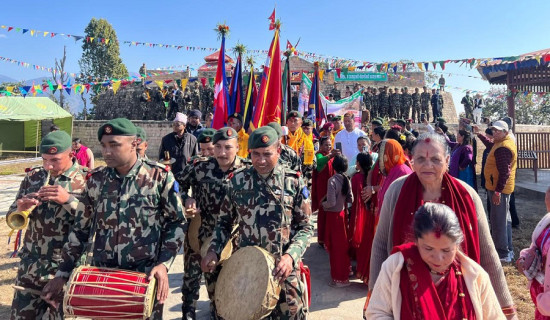- Thursday, 8 January 2026
Struggles For Recognition Bolster Inclusion
The unceasing struggle of Nepalis for recognition is a fight for their manifest visibility in public policy, representation in public institutions and media, social science inquiry and projection of self-worth. Recognition calls for the reflection of self-identity formation, affirming the values and acceptance of social, cultural and religious distinction and a distinct way of life in a national montage. The yearning for recognition evolves creative imagination about fulfilling vital human needs, the feeling of civic competence about the realisation of constitutional rights including freedom, self-respect and self-esteem. In no way, however, it discourages them from contributing to common good vital for establishing an edifice of a good society where mutual recognition can offer each Nepali an opportunity for social emancipation through personal and institutional means.
The rational nature of human beings is capable of surmounting the pre-rational human nature and legislating post-traditional constitution and policies, even acquiring enough sociability to foster international cooperation on the basis of just order. The gradual dissolution of traditional status-based hierarchical values to social contract has legitimised the equal recognition of Nepalis while the concept of human rights has elevated their right to humanity and the nation’s struggle for justice in global politics. Nepali constitution has recognised the nation as multi-ethnic, multi-linguistic, multi-cultural and multi-religious and evolved corresponding public policies and programmes for the material and psychological satisfaction of the people. It is recognition of the cultural preservation of the motherland.
Social pluralism
The provisions of shared and self-rule and national status to all languages spoken within the nation imply the practice of social pluralism even Prithvi Narayan Shah, the founder of modern Nepal, had recognised. Nepali language serves as a lingua franca. This has allowed Nepalis to raise their voices, aspirations and concerns. It transcends competition over interests and ideologies, helps people to internalise normative practices and expresses themselves on unsatisfied psychic and material needs for justice and symbolic world of cultural values. The nation has espoused social protection measures to those vulnerable to the challenges of dominant tradition and modernity. Micro-minorities of the nation seek the protection of their cultural survival and way of life. A myriad of indigenous groups celebrate their tradition, culture and values as a part of national mosaic.
Neither of them is distant from the influence of the nation’s civilization which helped the people to shift their loyalty from human nature to culture and inter-group inequality to politically co-equal people ensuring freedom of choice and an ability to uphold conscience.
Axel Honneth formulates three patterns of mutual recognition: first, emotional love within the sphere of family attachment. It springs from selfish genes and maximises survival and socialisation advantage. The second is legal rights within the sphere of civil constitution. It unleashes the process of citizenisation or Nepalisation and builds people’s national gaze, a sense of civic patriotism and self-determination so that recognition of subsidiary identities does not contest the national identity of Nepaliness.
In this sphere, Wll Kymlicka warns “Institutions and policies designed to promote citizanization in multi-ethnic states may be captured by internal and external actors who seek to perpetuate and exacerbate the enmity and exclusion.” Nepali leaders must be cautious enough about it and socialise people into civility, tolerance, common civic values and dense web of connections across the diversity as a remedy to transform pre-existing identities into national citizenship and ward off the connection of geopolitical forces to centrifugal elements eroding the national security of the state. Modernity and ideology have culture-transforming practices and, therefore, both aver cultural relativism.
The third is an orientation of people to social solidarity as a practical way of gaining recognition in the larger sphere of civil society and cosmopolitan ideals. The last one is a basis to organise collective action to resolve macro issues and problems where individual efforts are largely insufficient. The concept of solidarity is boundless as it goes beyond the primary and secondary circles of recognition to capture an overarching human aspiration for survival, dignity and humanity where Nepalis feel that they have responsibility to save other species and plants upon whom their survival depends. Ecological resilience, protection of chains of food production and supply, anti-nuclear movement, aversion to war and promotion of peace are universal goals for human survival and corresponding socialisation about ethical mode of life.
These realms provide a strong basis for social and system integration at various scales of governance and furnish resources for conflict resolution arising from a tension between recognition of individual self-assertion and social adjustment and adaptation. The system of rights offers space for social, economic and political interactions while solidarity provides leverage for desirable social transformation. Mutual recognition of Nepalis can easily end the patterns of denial to disadvantaged groups and individuals and fade the politics of difference just because they seek to nurture inclusive politics. Nepalis have collectively struggled for the establishment of democracy seeking to create social life in a normatively integrated community by the inner social nature of self and shift politics from purely power game to ethical construction for the transformation of social, economic and political relations.
In their democratic struggle for freedom, Nepalis have formed a post-traditional solidarity across caste, gender, ethnic, class and regional lines of identity, managed internal tension and created equal citizenship. This has eased collective political life both realistic and possible, overcome differences and reconcile rights with duties for political order and social peace. This has shaped the collective spirit of Nepalis, a sense of patriotism, aiming to defend themselves and their nation from the predators for the protection of national life. Nepalis have participated in many social struggles. The recent social struggle of shark loan victims demands justice and fairness in the treatment of economic relations, labour unions’ struggle as a collective identity of class is involved in collective bargaining for the just basis of political economy, fairness of their wage and welfare provisions.
The liberation of labour power is essential for their elevated participation and recognition as citizens and human beings. Women’s struggle is premised on gender equality, equal opportunity, equal outcome and recognition of their contribution to family, society and the nation. Their plea of the 'personal is political' offers conceptual foundation for the recognition of personal integrity and personal accountability. Ethnic groups’ struggle, glued by emotional relationships, is fused on organised social activities where they are associated with the demand of redistributive justice and recognition of their culture, code, symbols, identity and way of life. Dalits aspire for the elimination of caste prejudice, anticipate entitlements for social equality, equal status in both laws and facts and oriented to shared values and goals.
The multi-dimensional identity of Nepalis cannot be judged by the recognition of a single identity that subordinates them to instrumental politics of command, control and direction. The struggle of victims of cooperatives demands the retrieval of their investments. The disappearing tribes like Rautes, Chepangs, Badis, Hayus, etc. seek for their biological survival by building their capacity in multi-dimensional participation. Obviously, the collective aspiration of Nepalis for liberation, rights and social opportunity aims to construct a just society rooted in freedom, equality and social solidarity. Modern concept of human rights equally grants Nepalis the rights to work, development and self-determination at personal and group level.
Nepali media is filled with stories of individual experiences of suffering of deprivation, structural and direct violence just because they are poor, weak and women and do not have access to power. By invoking the right to information entrenched in the Nepali constitution they spotlight the plights of victims to national and global audiences, lodge a critique on governmental power and seek the rationalisation and humanisation of Nepali society. In this sense, the struggle for recognition of Nepalis becomes a structuring force for the democratic development and change. Nepali constitution has constituted several inclusive national commissions for women, Dalits, Muslims, Janajatis, Madhesis, Tharus, etc. to foster their group-based rights and recognition of identities.
Democratic awareness has provided a legal basis for the mutual recognition of their identities and formation of association for articulation. The pertinent questions are: Does it foster in them a sense of national identity of citizenship, an essential precondition for nation building? Or only affirm the subsidiary identity-recognition that tribalises Nepali society and undercuts the basis of a robust statehood capable of defending public and national interests in an impersonal manner? “Non-recognition,” according to Nancy Fraser means “being rendered invisible by means of the authoritative representational, communicative and interpretative practices of one's own culture and disrespect, being routinely maligned or disparaged in stereotype public cultural representations and in everyday interactions.”
Public platforms
Public platforms such as Tundikhel and Maitighar mandala are often filled with the struggle of people for the recognition of demands, symbols and identities of various caste and ethnic groups and those seeking for justice, formation of political will in the promotion of human rights. Newars, Magars, Gurungs, Rais, Limbus, Dhimal, Tharus, etc. organize their colourful festivals with songs, music, food and indigenous dress. Democracy in Nepal has allowed several groups to demonstrate their diverse identities and enabled them to struggle for recognition of their uniqueness. Nepali government also grants holidays for Lhosar, Phagu Purnima, Chhat, etc.
This is a process of inclusion of several cultural practices into Nepali culture and allows them to celebrate social practices so that they do not feel subordinated, ignored or marginalised. The unrealised political promises of leaders and constitutional rights owing to material and institutional deficiency amounts to the violation of their expectation of cultural dividends which might cause frustrated action, alienation, non-participation or extra-party participation thus causing political decay, not political development essential to foster civic culture of mutual recognition of equality of Nepali citizens.
(Former Reader at the Department of Political Science, TU, Dahal writes on political and social issues.)
















